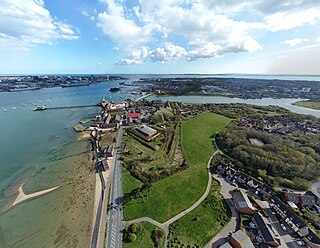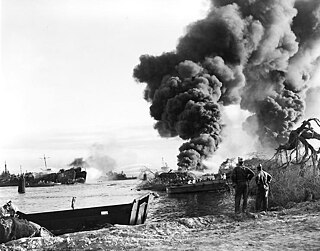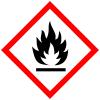Related Research Articles

The 1947 Texas City disaster was an industrial accident that occurred on April 16, 1947, in the port of Texas City, Texas, United States, located in Galveston Bay. It was the deadliest industrial accident in U.S. history and one of history's largest non-nuclear explosions.

The Port Chicago disaster was a deadly munitions explosion of the ship SS E. A. Bryan on July 17, 1944, at the Port Chicago Naval Magazine in Port Chicago, California, United States. Munitions being loaded onto a cargo vessel bound for the Pacific Theater of Operations detonated killing 320 sailors and civilians and injuring 390 others.

A magazine is an item or place within which ammunition or other explosive material is stored. The word is taken originally from the Arabic word makhāzin (مخازن), meaning "storehouses", via Italian and Middle French.

USS Mount Hood (AE-11) was the lead ship of her class of ammunition ships for the United States Navy in World War II. She was the first ship named after Mount Hood, a volcano in the Cascade Range in the US state of Oregon. On 10 November 1944, shortly after 18 men had departed for shore leave, the rest of the crew were killed when the ship exploded in Seeadler Harbor at Manus Island in Papua New Guinea. The ship was obliterated while also sinking or severely damaging 22 smaller craft nearby.

USS Mauna Loa (AE-8) an ammunition ship in service with the United States Navy. She was commissioned from 1944 to 1947, and recommissioned between 1955 and 1958 and from 1960 to 1969. Mauna Loa was finally scrapped in 1984.

The Picatinny Arsenal is an American military research and manufacturing facility located on 6,400 acres (26 km2) of land in Jefferson and Rockaway Township in Morris County, New Jersey, United States, encompassing Picatinny Lake and Lake Denmark. The Arsenal is the headquarters of the US Army Combat Capabilities Development Command Armaments Center. It is known for developing the ubiquitous Picatinny rail, as well as being the Army's center of expertise for small arms cartridge ammunition.
There have been many extremely large explosions, accidental and intentional, caused by modern high explosives, boiling liquid expanding vapour explosions (BLEVEs), older explosives such as gunpowder, volatile petroleum-based fuels such as gasoline, and other chemical reactions. This list contains the largest known examples, sorted by date. An unambiguous ranking in order of severity is not possible; a 1994 study by historian Jay White of 130 large explosions suggested that they need to be ranked by an overall effect of power, quantity, radius, loss of life and property destruction, but concluded that such rankings are difficult to assess.

USS Serpens (AK-97) was a Crater-class cargo ship commissioned by the United States Navy for service in World War II. She was the first ship of the US Navy to have this name: she is named after Serpens, a constellation in the northern hemisphere. Serpens was crewed by United States Coast Guard personnel and was responsible for delivering troops, goods and equipment to locations in the Asiatic-Pacific Theater.

Priddy's Hard is a former military installation in Gosport, England named for the original landowner and the firm beach found there. The site originated as a 1750s fort, and then became an armaments depot for Royal Navy and British Army weapons, explosives and other stores. The site was decommissioned in 1988, after over two hundred years of operation, with part now being developed for housing and an area retained as a museum.

USS Solar (DE-221), a Buckley-class destroyer escort of the United States Navy, was named in honor of Boatswain's Mate First Class Adolfo Solar (1900–1941), who was killed in action during the Japanese attack on Pearl Harbor on 7 December 1941.

Ammunition is the material fired, scattered, dropped, or detonated from any weapon or weapon system. Ammunition is both expendable weapons and the component parts of other weapons that create the effect on a target.
A sympathetic detonation, also called flash over or secondary/secondaries (explosion), is a detonation, usually unintended, of an explosive charge by a nearby explosion.

The West Loch Disaster was a maritime accident during World War II at Pearl Harbor U.S. Naval Base in Hawaii. The incident, which occurred just after 3 p.m. on Sunday, 21 May 1944, began following an explosion in a staging area for Landing Ships, Tank (LSTs) and other amphibious assault ships in West Loch. A fire quickly spread among the ships being prepared for Operation Forager, the invasion of the Japanese-held Mariana Islands. Over the next 24 hours, six LSTs sank, 163 naval personnel died, and 396 were injured.

SS El Estero was a ship filled with ammunition that caught fire at dockside in New York Harbor in 1943, but was successfully moved away and sunk by the heroic efforts of tugboat and fireboat crews, averting a major disaster.

Defence Munitions Gosport is a defence munitions site situated on the southwestern shores of Portsmouth harbour, southeast of Fareham in Hampshire, England. The site occupies about 470 acres. Its facilities include two Integrated Weapon Complexes (IWCs), 24 processing rooms and 26 explosives stores. The site employs some 270 staff.

The Roseville Yard Disaster was an accidental explosion and fire that occurred on April 28, 1973, at a major Southern Pacific rail yard in the city of Roseville, California. The shipment of munitions bound for the Vietnam War originated at the Hawthorne, Nevada Naval Ammunition Depot. Explosions continued for a number of hours and the loudest could be heard as far as 40 miles (64 km) away. There were no fatalities, although 48 people were injured.
YF-415 was a covered lighter in service with the United States Navy during World War II. It was accidentally sunk on May 11, 1944, while disposing of surplus explosive ordnance near Boston Harbor.
References
- ↑ "A Guide to Ammunition Storage" (PDF). p. 18.
- ↑ Schiffer, Thomas D. (2002). Peters & King: The Birth & Evolution of the Peters Cartridge Co. & the King Powder Co. Iowa, Wisc.: Krause. pp. 62–68. ISBN 0-87349-363-X.
- 1 2 Hampton Road BlogSpot accessed September 27, 2018
- ↑ "More than 200 killed in blasts in Rep. of Congo". CTVNews. 4 March 2012.
- ↑ Times, Astana (25 June 2019). "Kazakh President flies to Arys after deadly explosion at weapons depot, pledges full support to residents and restoration of town". The Astana Times.


